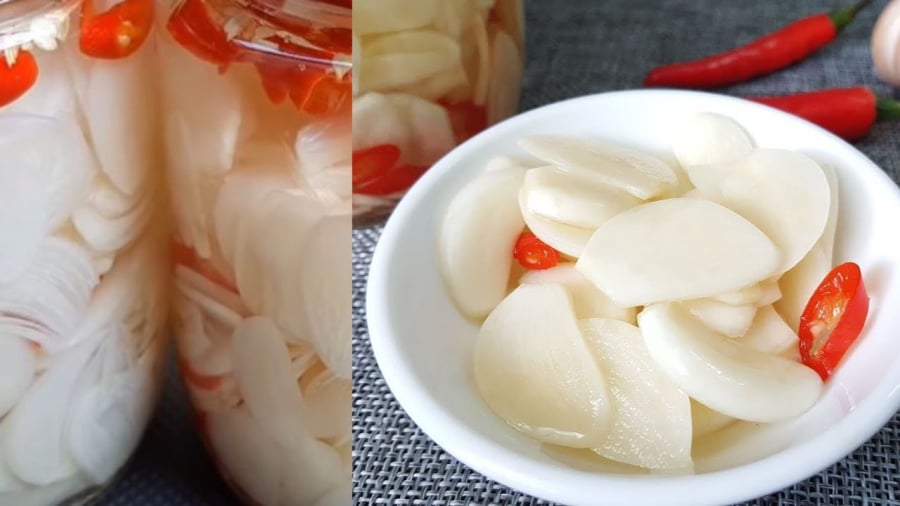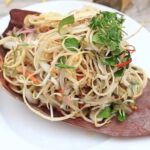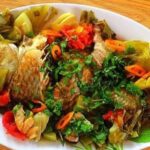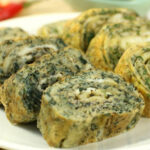Pickled garlic in chili vinegar is a common condiment in Vietnamese cuisine. It is a necessary addition to dishes such as pho, bun, mien, dipping sauces, fried rice, and crab soup. Pickled garlic enhances the flavor of these dishes, making them more delicious and satisfying.
However, many people encounter an issue when attempting to pickle garlic: it turns green. This green discoloration is unappetizing and off-putting to some, despite it being harmless to one’s health. The good news is that there are ways to prevent this from happening and to ensure your pickled garlic remains white and crisp.
Reasons for Garlic Turning Green
When garlic is peeled, chopped, and soaked, the compounds within the garlic react with the air. Younger garlic tends to have a stronger reaction, resulting in a more intense green color. While this discoloration is aesthetically unpleasing, it does not affect the safety of the garlic. You can still consume pickled garlic that has turned green, but if you want to avoid this issue and achieve white, crisp garlic without any scum, there are some tricks you can try.

Pickled Garlic – A Flavor Enhancer
Tips for Pickling Garlic Without the Green Discoloration
Ingredients
Select 200g of garlic or adjust the quantity based on your needs and the size of your pickling jar. Choose older, firmer garlic bulbs as they tend to be more fragrant, especially those with smaller cloves. Garlic with single cloves is generally more aromatic than those with multiple cloves.
Purchase a 500ml bottle of good-quality edible vinegar. Opt for a brand that has a clean, non-harsh flavor, free from industrial acid aftertaste.
Use fresh chili peppers according to your family’s preference for spiciness. If your family does not enjoy spicy food, you can omit the chilies altogether. You have the option to use various types of chilies such as bird’s eye chilies, bullet chilies, or horn chilies.
You will also need salt and filtered water.
Use a glass jar or a ceramic jar for pickling. Avoid plastic containers to prevent leaching of plastic additives, which can be harmful to your health.

Proper Pre-Treatment Ensures White, Crisp Garlic
Pickling Process to Prevent Greening
The greening of garlic is caused by a reaction between the garlic’s sap and the air. Younger garlic tends to have more sap, resulting in a stronger reaction and more intense greening.
To make the peeling process easier and faster, you can microwave the garlic for 10 seconds, making it easier to remove the skin. Use a knife to cut off the roots and peel the cloves.
Once peeled, slice the garlic into moderately thin pieces, avoiding extremely thick or thin slices.
Rinse the sliced garlic under running water to remove any residual sap, and then soak it in a dilute salt solution for about 30 minutes. Repeat the rinsing and soaking process 2-3 more times. The garlic’s pungent odor will diminish, along with the green color. You can also add a small amount of sugar to the soaking solution. To further sanitize the garlic and reduce the risk of scum formation, blanch the garlic in boiling water and then let it air dry.
This pre-treatment process ensures that the garlic remains crisp and reduces the likelihood of greening and scum formation during pickling.
Wash the chilies and let them air dry. Remove the seeds and slice them, or leave them whole, depending on your family’s preference. Adjust the amount of chili to suit your desired level of spiciness.
Preparing the Pickling Liquid
In a pot, combine vinegar, filtered water, a small amount of sugar, and salt. Heat the mixture until the sugar and salt dissolve. This process helps to dissipate the harsh aroma of the vinegar, resulting in a more refined pickling liquid. The addition of sugar also contributes to a more well-rounded flavor and speeds up the pickling process.
Alternatively, if you are short on time, you can skip cooking the pickling liquid and directly soak the garlic and chilies in the vinegar.
Pickling Process
Thoroughly clean a glass or ceramic jar and allow it to air dry. For added sanitation, you can boil the jar in water and then let it cool.
Once the garlic and chilies are prepared and dried, place them into the jar. Pour the cooled pickling liquid into the jar, covering the garlic and chilies completely. Store the jar in a cool, shaded area, away from direct sunlight and high temperatures. Within 2-3 days, the garlic will absorb the sour flavor and attain a crisp texture, indicating that it is ready for consumption. Avoid exposing the pickled garlic to excessive heat, as this can accelerate the souring process and affect the crispness of the garlic.
Garlic is a natural source of antibiotics and has digestive benefits. Regular consumption of garlic can help boost your immune system. When serving, use a clean spoon to remove the desired amount from the jar, and avoid returning any unused portion to the jar to prevent scum formation.
“A Tasty and Hearty Dish: Simmered Carp with Pickles”
“Discover the secret to creating a mouth-watering carp fish stew with pickled vegetables that will leave your taste buds tantalized. Impress your family and friends with this delicious dish that you can easily prepare in the comfort of your own home. It’s time to take your culinary skills to the next level!”
The Ultimate Guide to Mastering Sticky, Delicious Rice with an Electric Rice Cooker
“Mastering the art of cooking sticky rice to perfection in a rice cooker is no easy feat, but with our expert guide, you’ll be whipping up delicious batches with ease. Our step-by-step instructions will ensure your sticky rice is the talk of the town, with a texture that’s simply irresistible. Get ready to impress your taste buds and become the ultimate sticky rice connoisseur!”






































